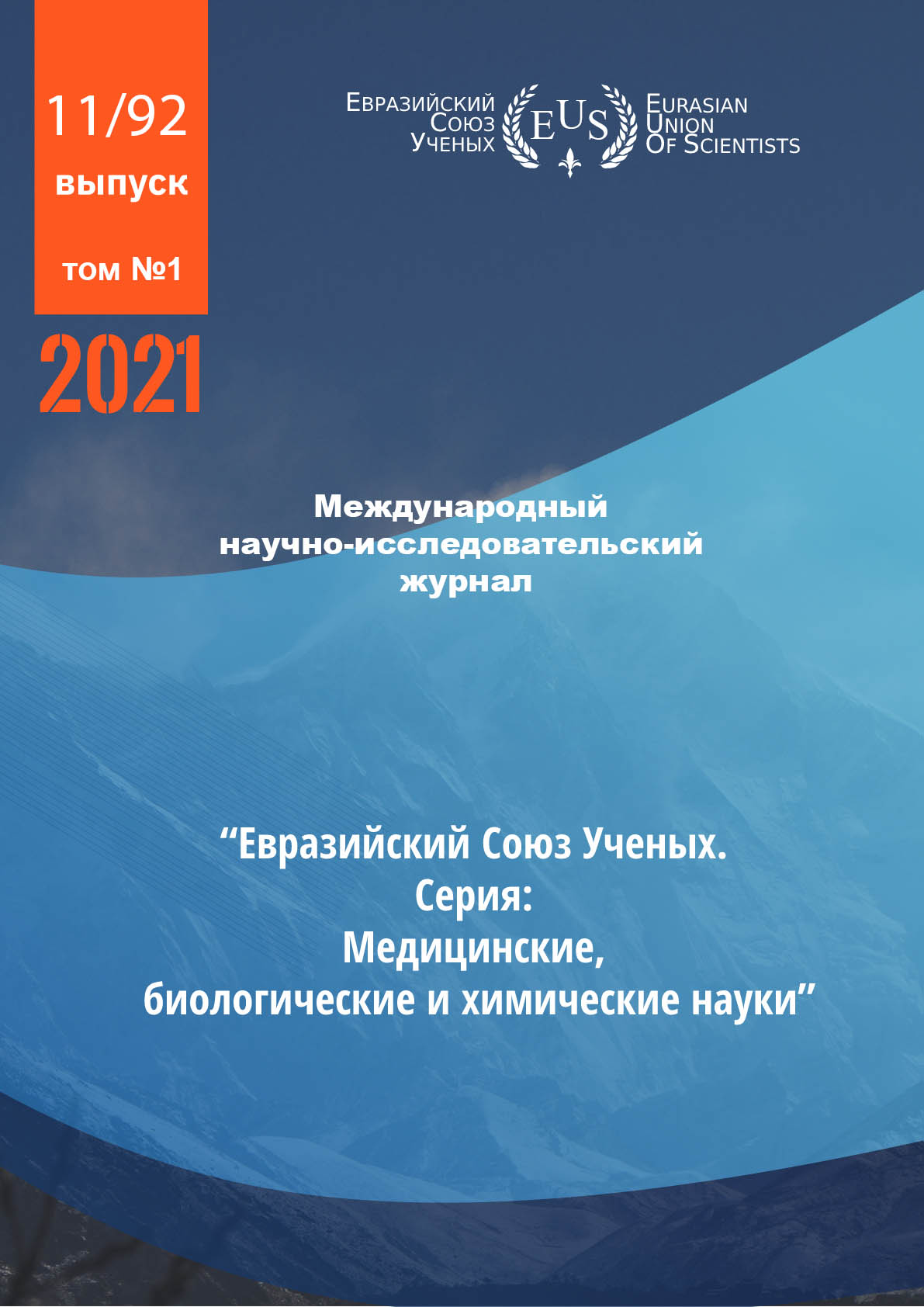MODERN VIEWS ON THE СLINIC-GENETIC ASPECTS OF POLYHYDRAMNIOS.
Abstract
The article analyzes the literature data on the etiopathogenetic aspects of polyhydramnios, taking into account the leading risk factors for development. Despite the knowledge of the etiological aspects, the development of diagnostic tactics and predictive methods, the frequency of polyhydramnios does not tend to decrease, but remains at the level of 3-12% of the total number of births. Being a leading medical and social problem, which leads to high childhood morbidity, disability, as well as death, negatively affecting the quality of life not only of a single family, but also on the gene pool of the nation.
References
Grebenkin, B.E. Rol infekcii rodovyh putej v razvitii vrozhdennyh porokov ploda / B.E. Grebenkin, S.G. Volina // Mat i ditya: mater. IV Rossijskogo foruma.- M., 2002.-Ch.1.-S. 242-243.
Gurev, A.V. Nevynashivanie beremennosti (etiologicheksie aspekty) / A.V. Gurev, A.A. Marchan, M.G. Chmaro // Nevynashivanie beremennostii nedonoshennyj rebenok: mater, nauch.-praktich. konf. Petrozavodsk, 2002. - S. 38-39.
Guseva, O.I. Mnogovodie: Etiologiya, patogenez, diagnostika i akusherskaya taktika / O.I.
Guseva // Ultrazvukovaya diagnostika. 1996.- №4. S. 5-13.
Guseva, O.I. Prognosticheskoe znachenie opredeleniya pokazatelej gormonalnoj, gemodinamicheskoj, immunnoj sistem fetoplacentarnogo kompleksa pri mnogovodii: avtoref.kand. med. nauk. Ivanovo, 1992.-24 s.
Dzhumakuliev, G.P. Patomorfologiya plodnyh obolochek, placenty i pupoviny pri malo- i mnogovodii u zhenshin v usloviyah Turkmenistana: avtoref. dne. kand. med. nauk.
Ashgabad, 1994.- 27 s.
Dobrotina, A.F. Dopplerometriya matochnoplacentarnogo i plodovo-placentarnogo krovotoka u beremennyh s mnogovodiem / A.F. Dobrotina, O.N. Guseva, I.Yu. Soboleva // Nizhegorodskij med. zhurn. -1992. -№1.- S. 20-23.
Elizareva, T.Yu. Znachenie perinatalnogo skrininga v vyyavlenii patologii ploda dlya prakticheskogo zdravoohraneniya / T.Yu. Elizareva, A.P. Fokina // Mat i ditya: mater. IV Rossijskogo foruma. -M., 2002. -4.1. -S. 33-34.
Zhigatova R.A., Beremennost, oslozhnennaya mnogovodiem, i ee ishody dlya materi, ploda i novorozhdennogo / avtoref. kand. med. nauk. Moskva,2004.-27s.
Kiselevich M.F. Techenie beremennosti i rodov u zhenshin s mnogovodiem/ Nauchnye vedomosti. -2013.-№25.-S.137-140.
Kulavskij E.V.Osobennosti techeniya beremennosti i rodov pri mnogovodii / avtoref. dne. kand. med. nauk. Ufa,2004.-26s.
Kulavskij E.V. Morfofunkcionalnoe sostoyanie amniona pri hronicheskom mnogovodii // Medicinskie tehnologii v ohrane reproduktivnogo zdorovya zhenshiny: Mat. Vserossijskoj nauchno- prakticheskoj konferencii. — Ekaterinburg, 2003.- S. 148-149.
Sidorenko V.N., Bugrov V.Yu., Kleckij S.K., Saharov I.V., Covremennyj vzglyad na etiopatogenez malovodiya i mnogovodiya, i puti ih resheniya pri mnogovodii infekcionnoj prirodoyu/Medicinskie novosti. 2018.-№4. S.53-57.
Marupova S.I. Rol serdechno-sosudistoj sistemy v razvitii mnogovodiya u beremennyh/ Vestnik molodyh uchenyh i specialistov Chelyabinskoj oblasti. 2015. -№3(10) s. 23-26.
Ordzhonikidze N.V., Ushnickaya E.K., Kan N.E., Zhigatova R.A. Kompleksnaya terapiya pri infekcionnom mnogovodii // Mat i ditya: Mater.VI Ros. foruma/-M, 2004. - S. 81..
Prytkov A.N., Zaharov L.V., Karkusova A.V. Vstrechaemost vrozhdennyh porokov razvitiya ploda pri patologicheskom soderzhanii okoloplodnyh vod u materi vo vremya beremennosti/Medicinskaya genetika. -2014.-№11- S.529-532.
Ushnickaya E.K., Ordzhonikidze N.V., Kan N.E., Zhigatova R.A. Akusherskaya taktika pri mnogovodii infekcionnogo geneza // Mat i ditya: Mater. V Ros. foruma/ -M., 2003. -S. 157-158.
Hamadyanov U. R. Taktika vedeniya beremennyh s mnogovodiem // Ohrana zdorovya materi i rebenka: Mat. 4-go Rossijskogo nauchnogo foruma. - M., 2002 - S. 377-378. (Soavt. Kulavskij E.V.).
Anderson DF, Jonker SS, Louey S, et al. Regulation of intramembranous absortion and amniotic fluid volume by constituents in fetal sheep urine/ Am J Physiol Regul Integr Comp Physiol/2013; 305:506-511.
Andreyko J.L., Chen C., Shennan A., Milligan J.// Am. J. Obstet. Gynecol.-2014. -.148.
Been J.V., Degraeuwe P.L., Kramer B.W., Zimmerman L.J.// BJOG.-2011.- Vol.118.-P.113-122.
Buchel, J. Differential diagnostic und Therapie das polyhydramnion/info@gynakologie.-2015.-Vol.4. -S. 16-18.
Ferell R.//Am. J.Florida/-2013.-P.70.
Pri-Paz S, Khalek N, Fuchs KM, et al. Maximal amniotic fluid index as a prognostic factor in pregnancies complicated by polyhydramnios. Ultrasound Obstet Gynecol. 2012; 39: 648-653.
Sandlin AT, Chauhan SP, Magann EF.Clinical relevance of sonographical estimated amniotic fluid volume. J Ultrasound Med. 2013; 32: 851-863
Magann E F, Chauhan S P, Barrilleaux P S. et al.Amniotic fluid index and single deepest pocket: weak indicators of abnormal amniotic volumes. Obstet Gynecol. 2000;96:737. [PubMed] [Google Scholar]
Moise Jr. KJ. Toward consistent terminology: assessment and reporting of amniotic fluid volume. Seminar Perinat. 2013; 37: 370-374/
Hamza, D. Herr, E. F. Solomayer,and G.Meyberg-Solomayer. /Polyhydramnios: Causes, Diagnosis and Therapy Geburtshilfe Frauenheilkd. 2013 Dec; 73(12): 1241–1246.doi: 10.1055/s-0033-1360163. Germaniya
Howman RA, Charles KA, Jacqes A, et al. Inflammatory and Haematological Markers in the Maternal, Umbilical cord and Infant Circulation in Histological Chorioamnionitis. Plos One. 2012;7(12): e51836.
CC BY-ND
A work licensed in this way allows the following:
1. The freedom to use and perform the work: The licensee must be allowed to make any use, private or public, of the work.
2. The freedom to study the work and apply the information: The licensee must be allowed to examine the work and to use the knowledge gained from the work in any way. The license may not, for example, restrict "reverse engineering."
2. The freedom to redistribute copies: Copies may be sold, swapped or given away for free, in the same form as the original.







